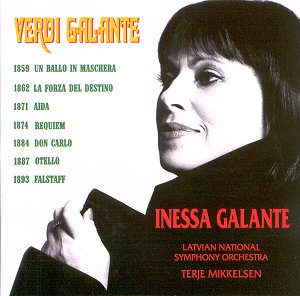It took me several hours to get through this.
Not, I hasten to add, because it was so boring I had to keep stopping
and starting again, but because, while I found plenty to enjoy
in each aria, a little voice inside me kept saying, "but
Iíd like to hear how so-and-so manages this or that part".
And so out came the CDs and LPs and it turned into a dayís work.
The Latvian soprano Inessa Galante has a splendid
voice, warm and rich and ringingly secure in fortes. She can also
float soft pianos, and these have just a touch of flutter which
is at the moment quite attractive so I hope it doesnít herald
any future problems. If you compare her with the young Renata
Tebaldi (in 1950, on Warner Fonit 5050466-2953-2-3) in two of
the arias which call for sustained, soft singing, O patria
mia and the Ave Maria, you will find a regal authority,
a rock-steadiness which was to grant her a career lasting many
years into the future.
Another question is that of style. Galante habitually
links notes with portamento, attacks notes from below and eases
into high notes rather than taking them head on. Now this is all
part of the Verdian style (at least some of the portamentos are
in the score), and if you listen to the very clean rendering of
Morrò, ma prima in grazia by Margaret Price, abetted
by Georg Soltiís ascetic accompaniment, you are likely to think
so much the better for Inessa Galante. But these devices, like
ornamentation in baroque music, are effective in inverse proportion
to the extent to which they are used. A comparison of the passage
Imprecherò la morte a RadamesÖ a lui chíamo pur tanto!
from Ritorna vincitor as sung by Galante and then as
sung by Maria Callas, Leontyne Price and Leonie Rysanek, and shows
that while the latter three are far from "scrubbed clean",
they place their expressive devices more judiciously, maintaining
a better sense of line and a more urgent communication. At times
I feel that Galante is applying these tricks of the trade conscientiously
rather than from inner necessity. Perhaps for this reason why
her drooping portamentos (arguably, Verdiís slurs in the score
mean he wants portamento) in Salce, salce draw attention
to themselves while those of Tebaldi and Rysanek do not.
And yet you could find Tebaldi the more mannered
in this particular piece, for while Galante and Mikkelsen treat
it as a haunting, slow aria (and so perhaps too little differentiated
from the Ave Maria), Tebaldi and Antonino Votto go hell
for leather and give a verismo interpretation which some will
feel more suited to Mascagni than Verdi (but itís thrilling!).
Rysanek and Arturo Basile show it is possible to find a middle
way.
If Iíve dwelt on these matters it is because
I feel that Galante has the voice and the musicality to match
some of the great names Iíve mentioned, so I hope she listens
to them and learns from them. If we make comparisons with contemporaries
rather than Golden Age singers, then I much prefer her to the
bumpy Renée Fleming in the Ave Maria, as I do, more
marginally, to Angela Gheorghiu in Pace, pace mio Dio,
though the latter has the advantage of a superbly urgent accompaniment
from Riccardo Chailly. Heard away from the comparisons, there
is plenty to sit back and enjoy, and only two items fail to make
their mark. In Sul fil díun soffio etesio Galante is unable
to lighten her voice (hear the smile on Marcella Pobbeís voice
in this piece) and in the extract from the Requiem she demonstrates
that she could contribute handsomely to a great performance of
this work if one were to hand but, while the chorus and orchestra
are good, the conductor is unable to stir them to a more than
merely decorous interpretation. At 14í 41" this is more than
two-and-a-half minutes longer than Fricsayís superbly taut DG
recording (with Maria Stader) and even outlasts the spineless
Giulini.
A general feature which emerged from the comparisons
is that an Italian conductor, be he Serafin, Votto, Basile or
other, is unlikely to adopt the lugubriously slow tempi for pieces
like O patria mia and Salce, salce chosen by non-Italians
such as Mikkelsen , Solti and others. From the booklet it can be
seen that opera does not figure largely in the career of either
the Latvian National Symphony Orchestra or of Terje Mikkelsen ,
and while they mostly acquit themselves with competence, this
may explain why the oboe plays, with loving artistry, a hideous
E flat instead of E natural just before the voice enters in O
patria mia. When I was young and innocent I thought conductors
(and maybe producers) were there to sort that sort of thing out,
but itís amazing what some of them donít notice.
The recording is good, in a slightly recessed
way Ė many of my older comparisons had a more exciting presence
Ė and there are useful notes in three languages, but the words
of the arias are not given. I hope my reservations wonít be too
discouraging because I do feel this is potentially a major talent.
Christopher Howell
